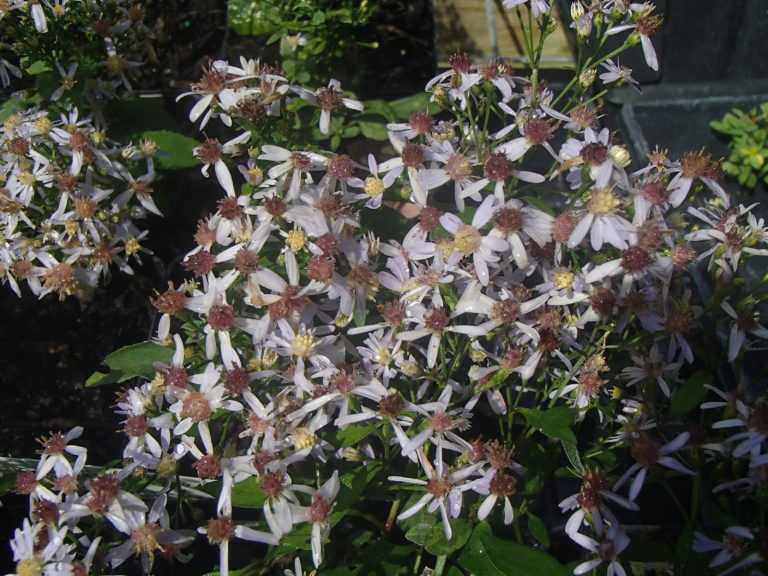White Wood Aster is a two foot-tall, rhizomatous, drought-tolerant herbaceous perennial which grows in open, dry woods and shady clearings in much of the Eastern U.S., including many mountain and piedmont couties in NC. This plant lights up shady, dry woodland sites with delicate white daisy-like flowers from September to November. The heart-shaped basal leaves make an attractive ground cover in spring and may be cooked and eaten as greens. White Wood Aster is a vigorous plant, even in dry shade, and thus can play an important role in difficult locations. Excellent for wildlife, it attracts butterflies and provides food and nesting material for Juncos, Sparrows and Goldfinches in winter, if left standing after flowering.
NURSERY HOURS
Wednesday: 10-4 Thursday: 10-6 Friday-Saturday: 10-4 Sunday: 12-4
Eurybia divaricata

Key Info
Scientific Name: Eurybia divaricata (L.) G.L. Nesom
Common Names: White Wood Aster
Family Names: Asteraceae (Composite, or Daisy Family)
Flower Color: White
Special Characteristics: Tolerates dry conditions, Attracts bees, Tolerant of Black Walnut, Attracts butterflies, Reported to be deer resistant., Tolerates shade
Additional Info
Habit: This plant grows from creeping, branched rhizomes, which are woody when established. First to emerge in spring are basal leaves forning a spring groundcover, followed by unbranched, nearly black, often zig-zag shoots supporting branched, termal flower heads.
Height: 1' - 2.5'
Spread: 1'-2'
Soil Conditions: Dry to medium moisture, acid to circumneutral pH.
Leaves: Basal leaves are small (2-3"), heart-shaped, stalked. Leaves on the stems are larger (up to 8" x 4" across), alternate, heart-shaped, with coarsely toothed margins and tapering to a point. Lower leaves are stalked, upper leaves with short stalks or no stalks.
Flowers (or reproductive structures: Small (1" wide), daisy-like flowers with drooping, white, outer petal-like ray florets surrounding the central yellow-turning-to-red, perfect disk florets; arranged in flat-topped, terminal clusters (corymbs) on hairy peduncles.
Fruit: In fall, brown, dry "cypsela" have deeloped -- a kind of elongated, ribbed seed with numerous white bristles for dispersal by wind.
Natural Distribution: Dry to mesic sites in mixed deciduous woods as well as on edges, clearings, and roadsides.
USDA Hardiness Zone: 3 to 8
USDA Wetland Indicator Status in NC: FACU
Pollination: Bees, butterflies, and other insects
Wildlife Connections: Leaves are host plant for the caterpillar of the Pearl Crescent butterfly. Flowers attract bees and butterflies. The seeds attact songbirds and small mammals.
Propagation: By seed.
